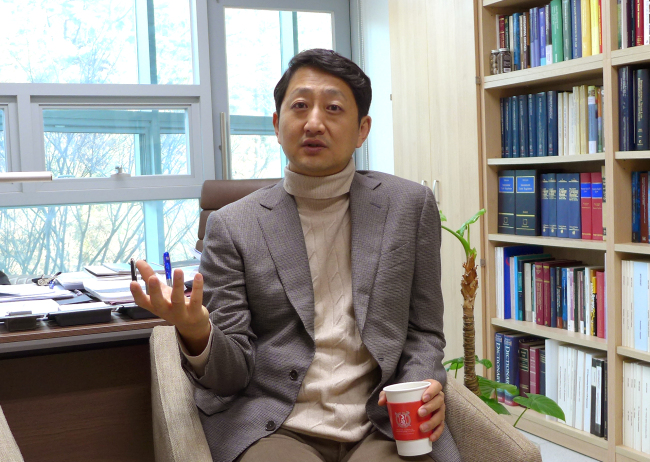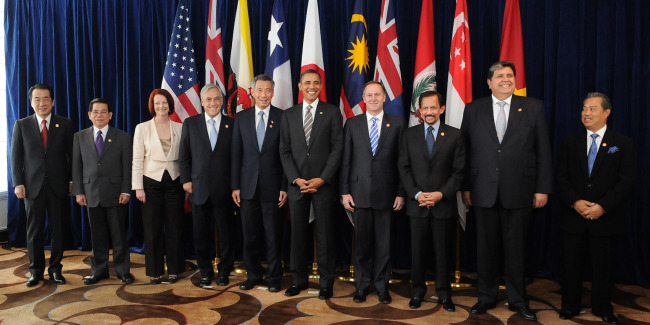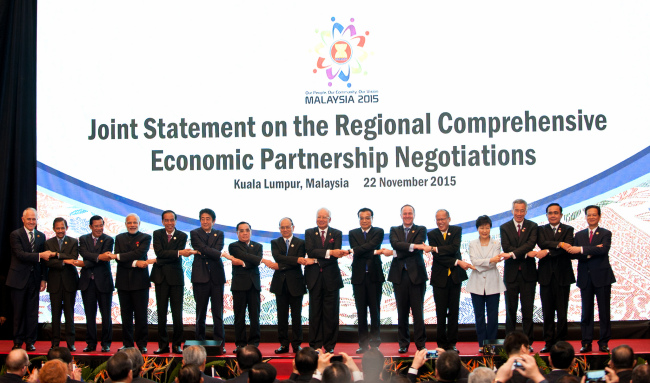[HERALD INTERVIEW] ‘Korea will be caught in crossfire of global trade’
By Korea HeraldPublished : Jan. 9, 2017 - 17:33
The Regional Comprehensive Economic Partnership will have far-reaching geostrategic implications, rather than substantially lowering trade barriers and rewriting economic rules, an influential economist has said.
The RCEP is a proposed free trade agreement between the 10 member states of the Association of Southeast Asian Nations and the six states -- Australia, China, India, Japan, South Korea and New Zealand -- with which ASEAN has existing free trade agreements.
Professor Ahn Duk-geun of Seoul National University’s Graduate School of International Studies, who teaches international trade law and policy, told The Korea Herald that due to the wide developmental discrepancies between ASEAN member states as well as between ASEAN and the six economies, the deal will be difficult to negotiate.
Even if the accord were to be agreed upon, the tariffs will not be significantly reduced, he projected.
The RCEP is a proposed free trade agreement between the 10 member states of the Association of Southeast Asian Nations and the six states -- Australia, China, India, Japan, South Korea and New Zealand -- with which ASEAN has existing free trade agreements.
Professor Ahn Duk-geun of Seoul National University’s Graduate School of International Studies, who teaches international trade law and policy, told The Korea Herald that due to the wide developmental discrepancies between ASEAN member states as well as between ASEAN and the six economies, the deal will be difficult to negotiate.
Even if the accord were to be agreed upon, the tariffs will not be significantly reduced, he projected.

The RCEP is largely spearheaded by China, which has jockeyed itself to engage with ASEAN and pull it under its sphere of influence. The regional FTA is seen as a counterweight to the Trans-Pacific Partnership, a mega-FTA involving 12 Pacific Rim countries led by the US and Japan, which US President-elect Donald Trump has vowed to undo.
“When one looks at the noneconomic aspects of RCEP, through the lens of the US-China rivalry, the deal would have hefty weight in terms of security and diplomacy in Asia,” Ahn said.
“If signed, it can put significant pressure on Washington, which has tried to expand its influence in Asia through its ‘Pivot to Asia’ policy under President Barack Obama. The deal can impact territorial disputes in the East China Sea and South China Sea.”
What current Washington policymakers are truly concerned with is TPP’s likely demise, as it was carefully designed to curb Beijing’s growing clout in Asia, according to Ahn.
“Trump’s China-bashing and promise to withdraw from the TPP have really complicated matters for policymakers on all sides, except China,” Ahn said. “If Trump follows through his belligerent rhetoric, he would effectively kill the goose that lays the golden eggs. He has dug his own grave, because scrapping the deal is wasting the opportunity to actually squeeze China, and reneging on his key plank would undermine his credibility.”
Japan is the only participating country to have ratified the TPP, steered by Prime Minister Shinzo Abe. The Japanese leader has staked his political fortune on his “Abenomics” economic policy -- comprising fiscal stimulus, monetary easing and structural reforms -- which critically hinges on the Pacific deal’s realization.

For the TPP to come into effect, at least six countries comprising over 85 percent of the 12 countries’ combined gross domestic product must ratify, necessitating the membership of both the US and Japan.
“The Obama administration pushed TPP alongside the Trade in Services Agreement (a proposed international trade treaty involving 23 countries, including the US, Canada, Australia, European Union, Korea and Japan), aimed at liberalizing the global trade of services such as banking, health care and transport,” the professor stressed.
He added that many regulations covering online and digital services have been incorporated into the TPP, and those pertaining to financial technology are included in the trade in services agreement.
The scholar also weighed in on the possibility of the TPP surviving, as the Republican Party and Wall Street financial interests have firmly supported it to check China’s rise.
Regarding the possible economic agenda of the incoming Trump administration, Ahn highlighted the real estate tycoon’s proposal to establish the National Trade Council in the White House, which would function as a control tower of American trade policy.
“What’s critically needed for Korea is instituting an office for the senior presidential secretary of trade inside Cheong Wa Dae, alongside the offices of national security and economic affairs” the professor asserted.
“This would act as a control tower of trade, and harmonize various repercussions of national policies. As seen by China’s alleged boycott of Korean products and services following the decision to deploy the Terminal High Altitude Area Defense system in Korea, diplomatic disputes can easily morph into economic troubles.”

Noting that governments worldwide are erecting trade barriers and ramping up protectionist measures, the professor forecast that this year would be arduous for the Korean economy, which has already laid off workers amid efforts at economic and industrial reforms.
“Recently, Korea’s trade has concentrated on ASEAN and other emerging markets, selling low-cost, lower-technology goods,” he said. “But the problem with this approach is that with reverse engineering on the back of economies of scale production, Chinese companies can catch up very quickly.”
Pointing out that Korea does not have an FTA with Japan, he contended that competing with innovative Japanese enterprises would enhance Korean firms’ long-term survivability. A free trade agreement between China, Japan and Korea could unlock “enormous potential,” he added.
Having a combined gross domestic product of over $16 billion -- roughly one-fifth of the world economy -- the three Northeast Asian countries would then comprise one of the world’s largest economic blocs, trailing behind the European Union and North American free trade union.
“If the three economies got together to establish new trade norms and opened their markets, it would have tremendous impact on the whole international trade system,” he said. “But currently there is no political commitment, as the three countries are mired in historical, diplomatic and security conflicts.”
As Korea already has an FTA in force with China and Japan has finished the legal groundwork on the TPP, the trilateral FTA could be positioned somewhere between the two, Ahn explained.
“As soon as the political will is there, the deal can take off quickly,” he said, adding Chinese President Xi Jinping and Japanese Prime Minister Abe have firmly entrenched their leadership. “Designing the China-Japan-Korea FTA is more important than RCEP. Once it comes into being, RCEP will be reorganized along the trilateral deal.”
By Joel Lee (joel@heraldcorp.com)
-
Articles by Korea Herald



















![[Today’s K-pop] Treasure to publish magazine for debut anniversary](http://res.heraldm.com/phpwas/restmb_idxmake.php?idx=642&simg=/content/image/2024/07/26/20240726050551_0.jpg&u=)